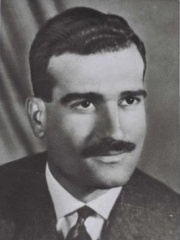
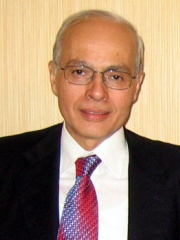

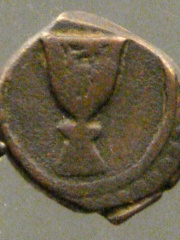
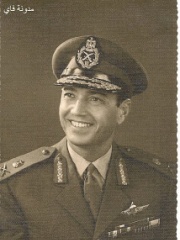


The Most Famous
MILITARY PERSONNELS from Egypt
This page contains a list of the greatest Egyptian Military Personnels. The pantheon dataset contains 2,058 Military Personnels, 8 of which were born in Egypt. This makes Egypt the birth place of the 34th most number of Military Personnels behind Georgia, and Hungary.
Top 8
The following people are considered by Pantheon to be the most legendary Egyptian Military Personnels of all time. This list of famous Egyptian Military Personnels is sorted by HPI (Historical Popularity Index), a metric that aggregates information on a biography's online popularity.

1. Eli Cohen (1924 - 1965)
With an HPI of 76.32, Eli Cohen is the most famous Egyptian Military Personnel. His biography has been translated into 41 different languages on wikipedia.
Eliyahu Ben-Shaul Cohen (Hebrew: אֱלִיָּהוּ בֵּן שָׁאוּל כֹּהֵן; Arabic: إيلياهو بن شاؤول كوهين; 26 December 1924 – 18 May 1965) was an Egyptian-born Israeli spy. He is best known for his espionage work in Syria between 1961 and 1965, where he developed close relationships with the Syrian political and military hierarchy. Though he was initially successful, Cohen's activity became increasingly risky and he expressed a sense of impending danger to Mossad in 1964. A year later, his true allegiance was uncovered by Syrian intelligence and he was convicted by the Syrian government under pre-war martial law. After being sentenced to death, he was publicly hanged in Damascus in May 1965. The incident contributed to the sharp escalation of hostilities between Israel and Syria just before the 1967 Arab–Israeli War. Cohen is highly regarded in Israel, with several streets and roads being named after him.

2. Ashraf Marwan (1944 - 2007)
With an HPI of 64.91, Ashraf Marwan is the 2nd most famous Egyptian Military Personnel. His biography has been translated into 18 different languages.
Mohamed Ashraf Abu El Wafa Marwan, known as Ashraf Marwan (Arabic: أشرف مروان 2 February 1944 – 27 June 2007), was an Egyptian official who was alleged to have spied for the Israeli Mossad, though former Egyptian president Hosni Mubarak later denied the claim. Other accounts contend that he served as a double agent for Egypt, providing misleading information to Israel. From 1969 on, Marwan worked at the Presidential Office, first under Gamal Abdel Nasser and then as a close aide to his successor, Anwar Sadat. In the lead-up to the Yom Kippur War in 1973, Marwan provided information to Israel. In the 1980s, Marwan moved to London, where he became an arms dealer. He died under mysterious circumstances on June 27, 2007, after falling from the balcony of his house in London. His wife and relatives testified that before his death, he expressed concerns that he was being followed.

3. Jawhar (911 - 992)
With an HPI of 63.61, Jawhar is the 3rd most famous Egyptian Military Personnel. His biography has been translated into 23 different languages.
Al-Qaid Jawhar ibn Abdallah (Arabic: جوهر بن عبد الله, romanized: Jawhar ibn ʿAbd Allāh, better known as Jawhar al Siqilli, al-Qaid al-Siqilli, "The Sicilian General", or al-Saqlabi, "The Slav" or the slave; born in Sicily and died 28 April 992) was a Fatimid general who led the conquest of Maghreb, and subsequently the conquest of Egypt, for the 4th Fatimid Imam-Caliph al-Mu'izz li-Din Allah. He served as viceroy of Egypt until al-Mu'izz's arrival in 973, consolidating Fatimid control over the country. After that, he retired from public life until his death. He is variously known with the nisbas al-Siqilli (Arabic: الصقلي, romanized: al-Ṣiqillī, lit. 'The Sicilian'), al-Saqlabi (Arabic: الصقلبي, lit. The Slav or the slave), al-Rumi (Arabic: الرومي, romanized: al-Rūmī, lit. 'the Roman'); and with the titles al-Katib (Arabic: الكَاتِب, romanized: al-Kātib, lit. 'the Secretary') and al-Qa'id (Arabic: القائد, romanized: al-Qāʾid, lit. 'the General').

4. Al-Salih Hajji (1372 - 1412)
With an HPI of 60.33, Al-Salih Hajji is the 4th most famous Egyptian Military Personnel. His biography has been translated into 17 different languages.
Al-Salih Hajji (Epithet: Al-Salih Salah Zein al-Din Hajji II), also Haji II, was a Turk Mamluk ruler, and the last ruler of the Bahri dynasty in 1382. He briefly ruled again in 1389, during the advent of the Burji dynasty. He fell hostage to Sayf ad-Din Barquq before the small battle of Marj al-Saffar in 1390. He was the son of Al-Ashraf Sha'ban.
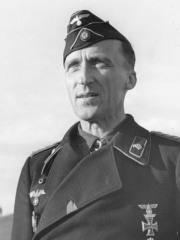
5. Walther von Hünersdorff (1898 - 1943)
With an HPI of 59.48, Walther von Hünersdorff is the 5th most famous Egyptian Military Personnel. His biography has been translated into 15 different languages.
Walther von Hünersdorff (28 November 1898 – 17 July 1943) was a German general during World War II who commanded the 6th Panzer Division. He was a recipient of the Knight's Cross of the Iron Cross with Oak Leaves and was killed during the Battle of Kursk.

6. Saad el-Shazly (1922 - 2011)
With an HPI of 59.41, Saad el-Shazly is the 6th most famous Egyptian Military Personnel. His biography has been translated into 19 different languages.
Saad el-Din Mohamed el-Husseiny el-Shazly (Arabic: سعد الدين محمد الحسيني الشاذلي, IPA: [sæʕd edˈdiːn elħoˈseːni eʃˈʃæzli]) (1 April 1922 – 10 February 2011) was an Egyptian military officer. He was Egypt's chief of staff during the Yom Kippur War. He is credited with the equipping and preparation of the Egyptian Armed Forces in the years prior to the successful capture of the Israeli Bar-Lev line at the start of the Yom Kippur War. He was dismissed from his post on 13 December 1973.

7. Sayf al-Din Khushqadam (1413 - 1467)
With an HPI of 59.26, Sayf al-Din Khushqadam is the 7th most famous Egyptian Military Personnel. His biography has been translated into 17 different languages.
Al-Malik al-Ẓāhir Sayf al-Dīn Abū Saʿīd Khushqadam ibn ʿAbdallāh al-Nāṣirī l-Muʾayyadī (Arabic: الظاهر سيف الدين خشقدم; c. 1404 – 9 October 1467) was a Mamluk sultan of Egypt and Syria from 28 June 1461 to 9 October 1467. He was born in Cairo, Egypt.

8. Al-Ashraf Kujuk (1334 - 1345)
With an HPI of 58.45, Al-Ashraf Kujuk is the 8th most famous Egyptian Military Personnel. His biography has been translated into 15 different languages.
Al-Ashraf Ala'a ad-Din Kujuk ibn Muhammad ibn Qalawun (Arabic: الأشرف علاءالدين كجك), better known as al-Ashraf Kujuk (also spelled Küçük/Küchük), (1334 – September 1345) was the Mamluk sultan from August 1341 to January 1342. He was a young child on the throne, and real power was held by his regent Emir Qawsun, a senior aid to Kujuk's father Sultan an-Nasir Muhammad (r. 1310–41). When Qawsun was ousted in a mamluk revolt in late December 1341, Kujuk was deposed in the weeks after. Kujuk was later murdered at the age of eleven as a result of the political intrigues in the sultanate.
People
Pantheon has 8 people classified as Egyptian military personnels born between 911 and 1944. Of these 8, none of them are still alive today. The most famous deceased Egyptian military personnels include Eli Cohen, Ashraf Marwan, and Jawhar.
Deceased Egyptian Military Personnels
Go to all RankingsEli Cohen
1924 - 1965
HPI: 76.32
Ashraf Marwan
1944 - 2007
HPI: 64.91
Jawhar
911 - 992
HPI: 63.61
Al-Salih Hajji
1372 - 1412
HPI: 60.33
Walther von Hünersdorff
1898 - 1943
HPI: 59.48
Saad el-Shazly
1922 - 2011
HPI: 59.41
Sayf al-Din Khushqadam
1413 - 1467
HPI: 59.26
Al-Ashraf Kujuk
1334 - 1345
HPI: 58.45
Overlapping Lives
Which Military Personnels were alive at the same time? This visualization shows the lifespans of the 4 most globally memorable Military Personnels since 1700.

